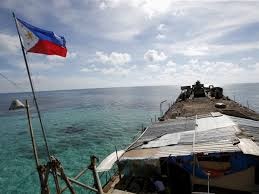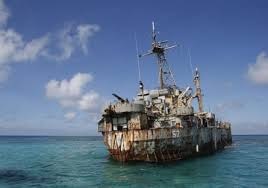A quiet tugboat, spotted recently near Ayungin Shoal, has brought the simmering tensions in the West Philippine Sea to a global flashpoint. At the heart of the standoff sits the BRP Sierra Madre—a grounded, rusting World War II-era ship that the Philippines deliberately ran aground in 1999. It is more than a military outpost; it is the ultimate symbol of national sovereignty, and its fate hangs heavy over the stability of the entire Indo-Pacific region.
For over two decades, a small, isolated detachment of Filipino marines has manned this deteriorating steel shell, maintaining a perilous presence on the front line of freedom. Now, China’s calculated “gray zone” tactics—involving constant patrols, psychological warfare, and the strategic positioning of heavy naval tugboats—are testing Manila’s resolve like never before. The central, defining question is dangerously clear: What happens if Beijing finally crosses the line?

Sovereignty Carved in Steel: The Genesis of a Standoff
The story of the BRP Sierra Madre is one of transformation, turning a humble wartime vessel into a monumental declaration of defiance.
Originally commissioned by the U.S. Navy during World War II, the ship served as a landing tank ship (LST), crucial for transporting troops and supplies across the Pacific Theater during the island-hopping campaign. After being transferred to the Philippine Navy in the 1970s, it led an unassuming life until 1999.
That year, as China escalated its island-building and occupation campaign across the Spratly Islands, Manila made a decisive, almost cinematic move. The Philippine government purposely grounded the aging vessel on Ayungin Shoal (Second Thomas Shoal), cementing a permanent, visible claim to the territory. This was not a distress signal; it was a defiant message written in steel: This is Philippine territory, and we are not retreating.
Since that day, the Sierra Madre has been the physical embodiment of the Philippines’ legal and moral claim, a living monument to the 2016 Hague Arbitral Ruling. This landmark decision invalidated China’s expansive “nine-dash line,” unequivocally stating that Beijing has no lawful basis for historic rights within the Exclusive Economic Zones (EEZ) of other states. The small band of soldiers enduring Spartan conditions inside the corroded hull ensures that this legal victory is made visible to the world every single day.
The Strategic Gold: Geography and the Gray Zone
The location of the Sierra Madre is pure strategic gold, making it the most critical geopolitical square inch in the region.
Within the EEZ: Ayungin Shoal lies just 105 nautical miles from Palawan, placing it squarely within the Philippines’ 200-nautical-mile EEZ as defined by the UN Convention on the Law of the Sea (UNCLOS).
The Forward Guard Post: Its position is dangerously close to China’s militarized outposts. To the west, only a few dozen nautical miles away, lies Mischief Reef, a key feature now converted by Beijing into a bristling military base with radar towers and missile sites.
A Tactical Triangle: The ship serves as a crucial forward guard post, forming a triangle of observation between China’s advanced positions and key Philippine-held bases like Pagasa Island.
In effect, the Sierra Madre is the thin, rusty wall standing between Chinese expansion and the heart of Philippine territory. Every supply drop and troop rotation is a conscious, high-stakes act of national will.
To remove the Sierra Madre would be a catastrophic loss: not only the erasure of a strategic outpost, but a profound symbolic blow that would signal to the world that China can rewrite the maritime map through persistence and intimidation, undermining years of sacrifice by the Filipino military.
Manila’s Red Line: Deterrence and the Mutual Defense Treaty
The tension surrounding the Sierra Madre has now been distilled into a clear, albeit strategically ambiguous, red line—a clear message to Beijing that some actions will trigger an undeniable response.
Philippine military officials, including Rear Admiral Roy Vincent Trinidad, have confirmed that the country has drawn an uncrossable line: any attempt by China to physically tow, dismantle, or seize the BRP Sierra Madre would constitute a direct attack on Philippine sovereignty.
This is not idle rhetoric; it is a calculated doctrine of deterrence rooted in the principle of strategic ambiguity. While contingency plans are reportedly in place, Manila refuses to publicly detail its response, forcing its adversary to constantly speculate on the cost of escalation. This psychological balancing act, used by the world’s most powerful militaries, turns the unknown into the ultimate deterrent.
The Alliance Threshold
Crucially, this red line is also a clear signal to Manila’s key ally, the United States. Washington has repeatedly affirmed that the 1951 Mutual Defense Treaty (MDT) would be invoked in the event of an armed attack on Philippine forces, public vessels, or aircraft in the South China Sea.
This means that a direct attempt to seize the ship could trigger a cascade of events:
-
Immediate Military Interception: Philippine Navy and Coast Guard vessels would move to deploy a deterrent posture.
Diplomatic Invocation: Manila would immediately consult with Washington, bringing the MDT into play.
Global Mobilization: The Philippines would instantly release footage and satellite evidence—a proven weapon of transparency—to rally international support and isolate Beijing.
The intentional ambiguity of the U.S. response timeline forces China to weigh the potential for a regional conflict, ensuring that the risk of crossing Manila’s red line is too high for rational calculation.
China’s Shadow War: The PLA Tugboat and Psychological Warfare
Beijing, for its part, is operating under a strategy of calibrated pressure, constantly testing the resolve of the Philippines and the credibility of the U.S. alliance. The recent sighting of a PLA Navy heavy-duty tugboat near the shoal is a prime example of this shadow conflict.
Intelligence analysts immediately flagged the naval tug—a vessel specifically designed for moving large structures—as a potential prelude to a towing operation. While Chinese officials claimed the vessel was merely providing “precautionary support,” the maneuver was a calculated probe intended to measure Manila’s and Washington’s response time and readiness.
Simultaneously, China’s official media amplified its psychological warfare, painting the Philippines as the aggressor for “illegal occupation” and warning of consequences for continued “infringements.” This classic strategy aims to:
Twist the Narrative: Flip the blame to confuse international audiences.
Signal Strategic Intent: Test the MDT’s credibility without firing a shot.
Normalize Encroachment: Apply slow, steady pressure just below the threshold of open conflict, aiming to make constant harassment the “new normal.”
The gray zone strategy seeks to achieve victory through attrition, relying on the world’s fatigue and short attention span to secure its territorial goals without combat.

Manila’s Calculated Response: Credibility and Alliances
Manila has evolved its response from passive protest to a calculated, multi-layered defense posture:
1. Military Modernization and Readiness
The Armed Forces of the Philippines (AFP) is undergoing a quiet, focused modernization drive, acquiring shore-based missile systems and integrating advanced naval and air surveillance capabilities. Furthermore, the massive Balikatan 2025 exercises—the largest in Philippine history, conducted side-by-side with the U.S. military—send an unambiguous message of combined readiness. Crucially, Manila has leveraged U.S. Intelligence, Surveillance, and Reconnaissance (ISR) systems, giving Philippine commanders real-time eyes on the contested waters.
2. Transparency as a Weapon
In a masterstroke of 21st-century diplomacy, the Philippine government has turned public transparency into a powerful deterrent. Instead of quietly filing diplomatic protests, Manila releases videos, satellite photos, and Coast Guard footage of Chinese aggression to the world. Every viral clip is a diplomatic victory that exposes China’s tactics and mobilizes global opinion, making truth itself a form of deterrence.
3. Alliance Signaling
The Philippines is strengthening its alignment beyond the U.S. with key regional partners, including Japan and Australia. Coordinated statements and joint maritime patrols across the Indo-Pacific uphold the principle of freedom of navigation, forming a united front against unilateral encroachment.
The Global Stakes: Law vs. Power
If China were to succeed in removing the BRP Sierra Madre, the economic and geopolitical shockwaves would be immense:
Regional Instability: Every country with maritime disputes—Vietnam, Malaysia, Indonesia—would see this as proof that intimidation trumps law, accelerating a regional arms race and tightening anti-China alliances.
Economic Collapse: The South China Sea is the conduit for over $3 trillion in annual global trade. A military confrontation or prolonged disruption here would severely destabilize global shipping, insurance, and energy supply chains from Asia to the Americas.
The Rules-Based Order: At its core, the standoff is a battle between law and power. The survival of the Sierra Madre is a direct test of whether international treaties and arbitral rulings hold any weight when challenged by a rising superpower.
The BRP Sierra Madre is not just a rusting hull; it is a declaration of national will and a lifeline for the international rules-based order. For 26 years, this old warship has braved storms and blockades, proving that sovereignty can endure, even in rust.
Manila’s calculated red line—a blend of deterrence, diplomacy, and readiness—reflects a nation that refuses to be bullied. The world is watching to see if this fragile, battered symbol of defiance can continue to hold the line against overwhelming pressure, determining the future not only of the Philippines but of maritime stability in Asia.





